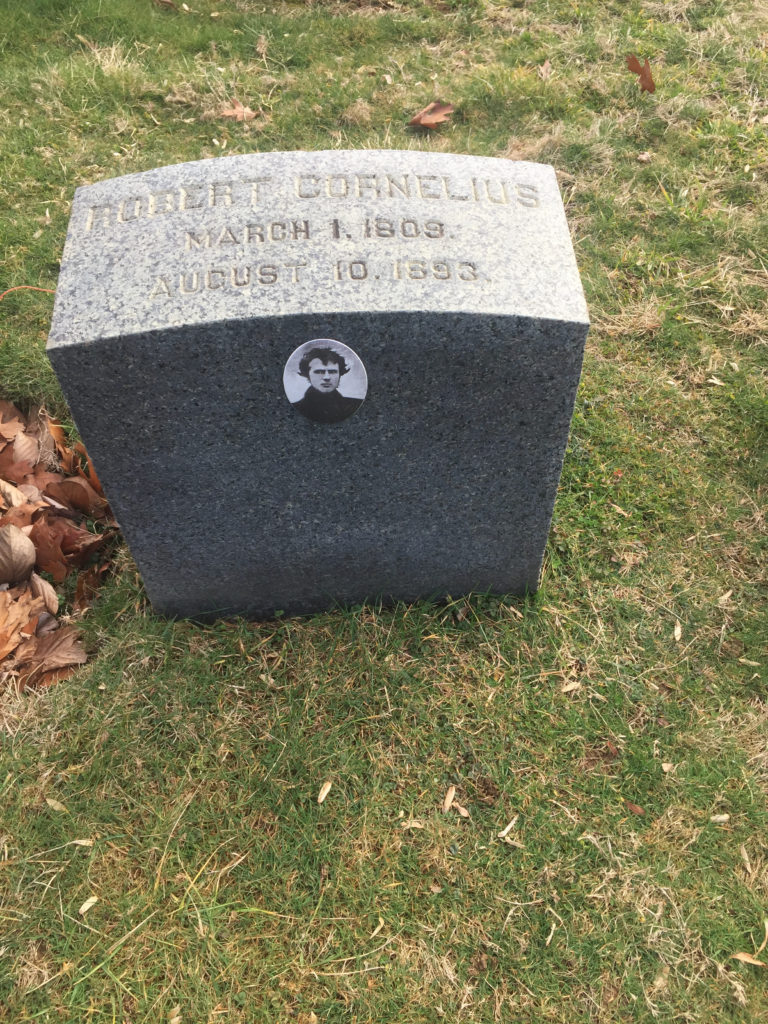Erik Visits an American Grave, Part 797
This is the grave of Robert Cornelius.

Born in Philadelphia in 1809, Cornelius grew up reasonably well off. His father was Dutch immigrant silversmith who opened a lamp manufacturing company. Cornelius went to real nice schools and developed a strong interest in chemistry. He also worked for his father, particularly on the silver side of the business.
Meanwhile, the early techniques of photography had begun to develop. Joseph Saxton, a Philadelphia watchmaker, became interested in this new technology. In 1839, Saxton wanted to try and create a daguerreotype of the view from his office window. So he asked Cornelius to develop the silver plate for it. This is the oldest known photograph in American history. It is extremely rudimentary but also fascinating.

Being involved in this got Cornelius quite interested in photography himself and he saw an economic opportunity. By October 1839, he took a picture of himself. This is first picture of a person taken in the United States and probably the second ever, behind one in France.

This early photography was an exercise in both chemistry and being incredibly still. For the picture above, he had to be still for about 15 minutes. It took quite awhile before photography developed where this wasn’t needed. In fact, you can read lots of accounts of people complaining about how uncomfortable photography was, what with sticks being shoved into your back to stop you moving. But then it surely wasn’t worse than the experience of having your portrait painted or masks and casts created and all the other ways in which people wanted them self-memorialized in art. As for the chemistry, while Cornelius was quite adept himself, for this, he also worked with another chemist named Paul Goddard, who became the first person to use bromine to develop the pictures, which significantly reduced the time it would take. Goddard would later become a quite prominent Civil War doctor.
In 1841, Cornelius opened the first photography studio in the U.S. He only ran it for two years, closing it 1843. He seems to have lost interest or realized that he wasn’t going to make the money he hoped in it. By that time, there was definitely competition. A lot of the photographs were of people and that makes sense; they paid. But I find the very few images of antebellum cities vastly more interesting, fragments of a lost world of wooden cities that burned frequently, of muddy streets laden with a nice big thick layer of horse shit from the animals used for transport, etc. This an 1840 photo of 8th and Market Street.

You cannot convince me that there’s not a world of analysis that can be made out of that.
Cornelius may have given up on photography, still remained an important figure. By 1843, whale oil was becoming incredibly expensive because, you know, Americans were hunting these animals to near extinction in order to light their homes. Cornelius realized the need for alternative energy sources. He invented something he called the “solar lamp” though it did not use solar energy. Instead, it burned lard. He made a ton of money on this and it sold throughout both the U.S. and Europe. He also created the first kerosene lamps. He didn’t make that much money on this though because quite quickly other companies figured out how to do it better and cheaper.
Interestingly, while Cornelius later claimed to have taken photographs in 1839, no one really knew whether this was true. It wasn’t until 1975 that his work was discovered in the American Philosophical Society.
Cornelius retired in 1877 and lived at his mansion outside of Philadelphia. He died there in 1893.
Robert Cornelius is buried in Laurel Hill Cemetery, Philadelphia, Pennsylvania.
This grave visit was sponsored by LGM readers, part of my last pre-pandemic trip, back when the world was young. Of course now that the world is old and so am I, grave visits are happening again. So if you are interested in this series visiting other American photographers, you can donate to cover the required expenses here. Diane Arbus is in Hartsdale, New York and Robert Capa is in Amawalk, New York. Previous posts in this series are archived here.
